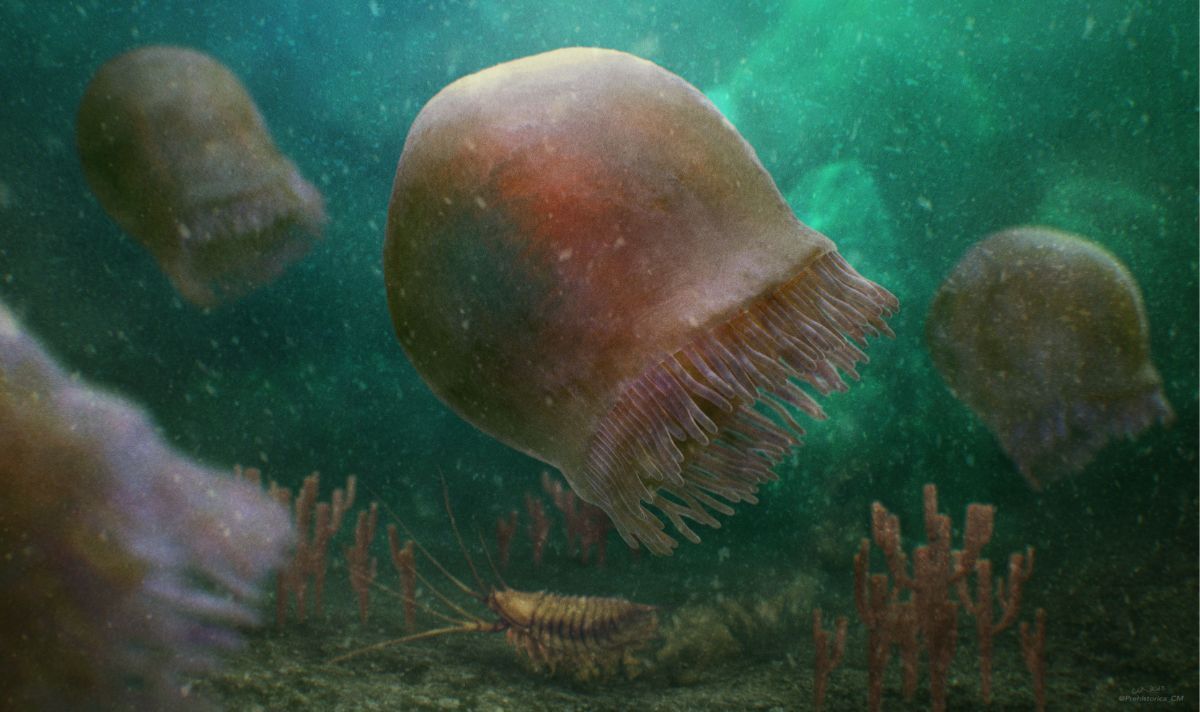Palaeontologists have revealed the oldest-known species of free-swimming jellyfish — which they found in 505 million-year-old rocks from western Canada.
Dubbed Burgessomedusa phasmiformis, the beautiful creatures had bell-shaped bodies that reached up to nearly eight inches long.
Their preservation in the rock record is remarkable — given how jellyfish tend to be made up of nearly 95 percent water — but researchers have found nearly two hundred specimens.
The astounding fossils show details of the jellyfish’s internal anatomy, as well as their tentacles, which the researchers believe would have allowed it to catch sizable prey.
The findings show that the food chain 500 million years ago was more complex than thought, with large swimming arthropods not the only predators.
READ MORE: Wales was ‘marine dwarf world’ 462 million years ago, fossils show
The study was undertaken by palaeontologist Joe Moysiuk of the University of Toronto and the Royal Ontario Museum (ROM) and his colleagues.
Mr Moysiuk said: “Jellyfish and their relatives are thought to be one of the earliest animal groups to have evolved.”
However, he noted, “they have been remarkably hard to pin down in the Cambrian fossil record.”
Spanning from 538.8–485.4 million years ago, the Cambrian Period is a time known for an explosion in the diversity of life and the emergence of the major animal groups.
We use your sign-up to provide content in ways you’ve consented to and to improve our understanding of you. This may include adverts from us and 3rd parties based on our understanding. You can unsubscribe at any time. More info
Cnidarians — the phylum that includes jellyfish but also corals and sea anemones — have complex life cycles that can include multiple body forms.
In medusozoans, this includes vase-like polyps, and then a bell- or saucer-shaped body called a “medusa” or, more commonly, a jellyfish. The latter are usually free-swimming, but sometimes can be stalked.
Although palaeontologists have discovered examples of fossil polyps in rocks dating back to around 560 million years ago, the origin of free-swimming medusa has been unclear.
However, Mr Moysiuk added: “This discovery leaves no doubt that they were swimming about at that time.”
DON’T MISS:
Paralysis breakthrough as feeling and movement restored to man with quadriplegia[ANALYSIS]
Divers make disturbing discovery at the bottom of huge mysterious ocean sinkhole[INSIGHT]
London’s hidden Roman Wall section sees light of day in ‘brilliant’ exhibition[REPORT]
While only recently identified, the fossils of B. phasmiformis were first collected during the late eighties and the nineties by former ROM Curator of Invertebrate Palaeontology Desmond Collins.
The geological deposit they are found in is known as the Burgess Shale — in fact, it is from this that the genus Burgessomedusa gets the first part of its name.
The Burgess Shale outcrops in the Rocky Mountains, in the Yoho and Kootenay National Parks.
Paper co-author Dr Jean-Bernard Caron — an invertebrate paleontologist at the ROM — said: “Finding such incredibly delicate animals preserved in rock layers on top of these mountains is such a wondrous discovery.
Dr Caron continued: “Burgessomedusa adds to the complexity of Cambrian food webs, and like Anomalocaris which lived in the same environment, these jellyfish were efficient swimming predators.”
(Anomalocaris — whose name means “abnormal shrimp” — is a bizarre, armoured marine creature with compound eyes often dubbed the world’s first apex predator.)
Dr Caron added: “This adds yet another remarkable lineage of animals that the Burgess Shale has preserved chronicling the evolution of life on Earth.”
Specimens of B. phasmiformis have recently been put on display for the public in the Burgess Shale section of the ROM’s Willner Madge Gallery.
The full findings of the study were published in the journal Proceedings of the Royal Society B Biological Sciences.
Source: Read Full Article







